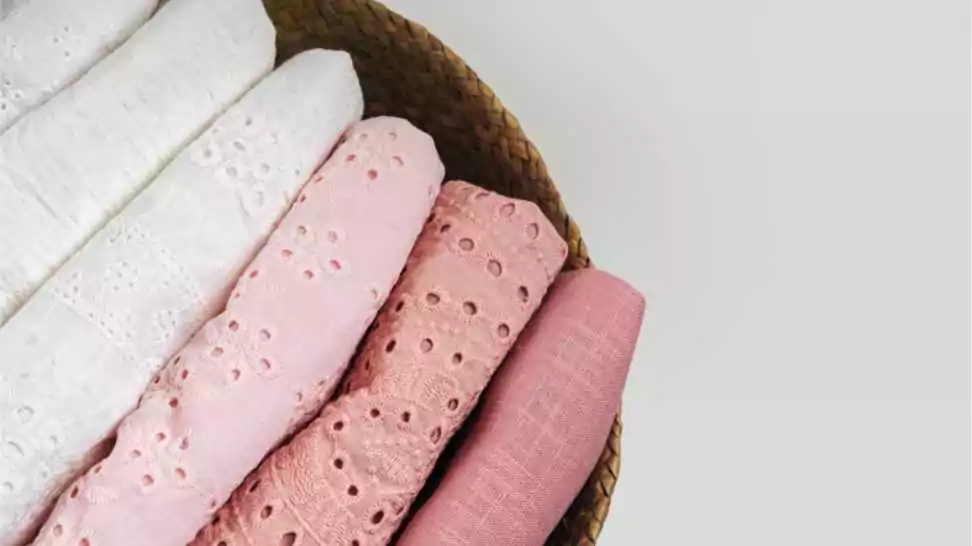How To Make A Baby Swaddle?

Swaddling, an age-old method of snugly wrapping a baby in a blanket, stands out for its ability to soothe and calm infants, fostering better sleep. This practice, which simulates the cosiness of the womb, has been an integral part of baby care for generations.
In this guide, we delve into the nuances of swaddling. You’ll learn why it’s essential for your baby’s comfort and well-being and how to make a baby swaddle and swaddle sack. This article is designed to equip new parents, caregivers, or anyone interested in this timeless technique with the necessary skills to effectively swaddle a baby, ensuring a warm, comforting transition into the world. Join us as we reveal the secrets of swaddling for your little one’s ultimate comfort.
1 Understanding Swaddling
Swaddling, at its core, is the practice of wrapping a baby tightly in a blanket or cloth, creating a snug environment that resembles the mother’s womb. This age-old technique is not a recent innovation; it has been a part of various cultures around the world for millennia. Historical records and artefacts suggest that swaddling dates back as far as 4000 years. Different civilizations have embraced swaddling, each with its unique style and method, but the underlying principle has always been the same – to provide warmth, security, and comfort to the newborn.
Why Swaddle? The Benefits Explained
The advantages of swaddling are numerous, particularly in the early stages of a baby’s life. Some of the key benefits include:
- Enhanced Sleep Patterns: Swaddling helps in reducing the startle reflex, which can wake a baby abruptly. This snug wrapping thus promotes longer, more peaceful sleep periods.
- Soothing Comfort: The snugness of a swaddle replicates the cosy, confined environment of the womb, offering a sense of security and comfort to the baby.
- Temperature Regulation: Proper swaddling can help maintain a baby’s body temperature, keeping them warm and cosy without the risk of overheating.
- Reduced Anxiety: Both for the baby and the parents, swaddling can reduce stress levels. A well-swaddled baby often cries less, providing a sense of accomplishment and confidence to new parents.

Timing is Everything: When to Swaddle and When to Stop
Swaddling is most beneficial during the first few months of a baby’s life. It is typically recommended for newborns and can be continued until the baby shows signs of rolling over or breaking free from the swaddle. This milestone usually occurs around the age of 2 to 4 months. Once the baby starts rolling, it’s time to transition away from swaddling to prevent the risk of suffocation or Sudden Infant Death Syndrome (SIDS). It’s important to be aware of these developmental signs and adjust your swaddling routine accordingly.
2 Choosing the Right Material
Selecting the Ideal Fabric for Swaddling

The choice of fabric is a critical aspect of swaddling. It can make the difference between a restful night and an uncomfortable one for your baby. When it comes to swaddling and swaddle sacks, not all materials are created equal. Here’s a guide to help you choose the best fabric for your little one:
- Cotton Muslin: A highly popular choice for swaddles, cotton muslin is lightweight, breathable, and gets softer with each wash. Its open weave allows for air circulation, reducing the risk of overheating.
- Bamboo Rayon: Known for its softness and thermal regulating properties, bamboo rayon is an excellent choice for sensitive baby skin. It’s eco-friendly and provides a stretchier wrap compared to cotton.
- Jersey Knit: If you’re looking for elasticity, jersey knit fabrics are ideal. They offer a stretch that allows for a snug swaddle, conforming comfortably to the baby’s body.
- Organic Fabrics: For parents who prefer organic options, there are organic cotton, bamboo, and wool swaddles available. These fabrics are free from harmful chemicals and are gentle on the baby’s skin.
Safety First: Breathable and Soft Materials
When swaddling your baby, safety should always be your top priority. Here are some key considerations:
- Breathability: Choose fabrics that allow for proper air circulation to prevent overheating. Overheating is a risk factor for SIDS, so a breathable fabric is essential.
- Softness: A baby’s skin is delicate and sensitive. Selecting a fabric that is soft and gentle to the touch can prevent irritation and provide more comfort.
- Weight and Thickness: Opt for lighter and thinner fabrics, especially in warmer climates. In cooler temperatures, slightly thicker fabrics can be used, but always ensure they are breathable.
Tips for Fabric Selection
- Washability: Babies can be messy, so choose a fabric that is durable and easy to wash.
- Allergies and Sensitivities: If there’s a history of skin allergies or sensitivities in your family, consider hypoallergenic fabrics.
- Seasonal Considerations: Adjust the weight and type of fabric based on the season to keep your baby comfortable year-round.
- Test for Stretch: A good swaddle fabric should have a slight stretch to it, allowing for a snug fit without being too restrictive.
3 Basic Swaddle Wrap Technique

Learning how to make a baby swaddle is an essential skill for new parents. Swaddling can be a soothing practice for your baby, helping them feel secure and comfortable. Here’s a step-by-step guide to creating a basic baby swaddle:
- Start by finding a flat, soft surface like a bed or a changing table.
- Lay your chosen swaddle cloth in a diamond shape on the surface. Fold down the top corner about 6 inches to create a straight edge.
- Gently lay your baby face-up on the cloth, with their head above the folded edge. Ensure their shoulders are just below the fold.
Wrapping Techniques
- Left Side Tuck: Take the left side of the cloth and wrap it over your baby’s chest. Tuck it under the right side of their body, ensuring one arm is securely swaddled.
- Bottom Up: Fold the bottom corner of the cloth over your baby’s feet. Tuck this part into the first fold, around your baby’s chest.
- Final Wrap: Pull the right side of the cloth across your baby’s body, wrapping it snugly. Tuck the excess cloth under your baby to secure the swaddle.
Common Mistakes and How to Avoid Them
- Too Tight a Wrap: While a snug swaddle is necessary, ensure it’s not too tight. Your baby should be able to move their hips and legs freely to prevent hip dysplasia.
- Covering the Face: Always keep the cloth away from your baby’s face to ensure easy breathing.
- Overheating: Be mindful of the room temperature and the thickness of your swaddle cloth. Overheating can be dangerous for babies.
- Ignoring Baby’s Cues: Some babies may not enjoy being swaddled. Pay attention to your baby’s cues and comfort level.
4 Transitioning to a Swaddle Sack

As babies grow, they may begin to resist traditional swaddling or need more room to move. This is where a swaddle sack comes into play. Swaddle sacks provide the snugness of a swaddle while allowing for more movement, especially for the arms and legs. They are ideal for transitioning out of a swaddle while still offering the comfort and security babies are used to. Here’s how to make a baby swaddle sack:
Introduction to Swaddle Sacks and Their Benefits
Swaddle sacks are designed to provide a more flexible swaddling experience. They offer a safe alternative for babies who have started rolling over but still need the comforting sensation of being swaddled. Key benefits include ease of use, safety, and adaptability to a baby’s growing need for movement.
Detailed Instructions on How to Make a Baby Swaddle Sack
Materials and Preparation
- Choose a soft, breathable fabric like cotton or bamboo rayon. You’ll need about 1 yard of fabric.
- Measure your baby’s length from shoulder to feet and add about 6 inches for the sack’s length. For the width, measure your baby’s wingspan (fingertip to fingertip) and add a few inches for comfort.
Cutting the Fabric
- Draw the sack outline on the fabric based on your measurements. The shape should resemble a long, narrow rectangle with a rounded bottom. Cut out the fabric accordingly.
Sewing the Sack
- Start by hemming the top and bottom edges of the fabric.
- Fold the fabric in half with the inside out. Sew along the long edge and around the rounded bottom, leaving the top open.
- Cut out small armholes on each side, about a quarter way down from the top. Hem around these holes to prevent fraying.

Decorating and Personalising Your Swaddle Sack
- Add Decorative Elements: Feel free to add embellishments like ribbons, appliques, or embroidery to personalise the swaddle sack.
- Final Touches: Turn the sack right-side out. You can add Velcro or a zipper for easy opening and closing.
5 Safety Tips and Best Practices
While swaddling can be a great tool for comforting and soothing your baby, it’s essential to follow certain safety tips and best practices to ensure your baby’s well-being.
Ensuring the Swaddle is Not Too Tight
- Check the Fit: A good rule of thumb is to make sure you can fit two to three fingers between the swaddle and your baby’s chest. This ensures that the swaddle is snug but not too tight.
- Monitor Hip Movement: The swaddle should be loose enough around the hips and legs to allow free movement. Tight swaddling can lead to hip dysplasia, a condition where the hip joint doesn’t form correctly.
Recognizing Signs of Overheating
- Understand the Symptoms: Signs of overheating include sweating, damp hair, flushed cheeks, heat rash, and rapid breathing.
- Adjust Layers Accordingly: If the room is warm, consider using a lighter swaddle fabric or fewer layers. Always monitor the room temperature and dress your baby accordingly.
Balancing Swaddling with Supervised Tummy Time
- Promote Motor Development: While swaddling is beneficial for sleep and soothing, it’s important to balance it with supervised tummy time when your baby is awake. This helps in strengthening their neck, shoulder, and arm muscles.
- Create a Routine: Incorporate tummy time into your baby’s daily routine, starting with a few minutes at a time and gradually increasing as they grow stronger.
6 Washing and Caring for Your Swaddle and Swaddle Sack
Proper care and maintenance of your baby’s swaddle and swaddle sack are crucial for hygiene and to ensure these items remain comfortable and durable. Here are some tips for washing and caring for your swaddle and swaddle sack:
Maintaining Hygiene
- Regular Washing: Given that babies can be messy, it’s important to wash swaddles and swaddle sacks regularly. This helps in maintaining hygiene and keeping the fabric fresh and clean.
- Immediate Attention to Stains: If there are any stains, treat them as soon as possible to prevent them from setting in.
Washing Instructions
- Read Care Labels: Always check the care labels on your swaddle and swaddle sack for specific washing instructions.
- Gentle Detergents: Use mild, baby-friendly detergents to avoid irritating your baby’s sensitive skin.
- Lukewarm Water: Wash swaddles and swaddle sacks in lukewarm water to help preserve the fabric’s quality and softness.
- Separate Colours: To prevent colours from bleeding, wash light and dark colours separately.
Drying Instructions
- Air Dry When Possible: Air drying is the best way to preserve the fabric’s quality. If you use a dryer, opt for a gentle, low-heat cycle.
- Avoid Direct Sunlight: While air drying, avoid placing them in direct sunlight as this can cause the colours to fade.
Preserving Fabric Quality
- Avoid Harsh Chemicals: Bleach and fabric softeners can break down the fibres and affect the fabric’s softness and durability.
- Gentle Ironing: If you need to iron the swaddle or swaddle sack, do it on a low heat setting to avoid damaging the fabric.
7 Wrapping Up
As we conclude, it’s evident that swaddling is key in nurturing a baby’s early life, providing comfort, security, and improved sleep. This guide has covered everything from selecting the right fabric to perfecting the swaddle wrap and transitioning to a swaddle sack, all essential for your baby’s well-being.
We’ve highlighted the importance of safety, like ensuring a loose fit to prevent overheating and complementing swaddling with tummy time for development. We also discussed maintaining hygiene and fabric care for your swaddles.
Beyond just technique, swaddling is a chance for creative expression. Personalising swaddles or swaddle sacks can be deeply rewarding, allowing you to meet your baby’s unique needs while adding a personal touch.
Community Q&A
About This Article
This article has been viewed 85 times.



